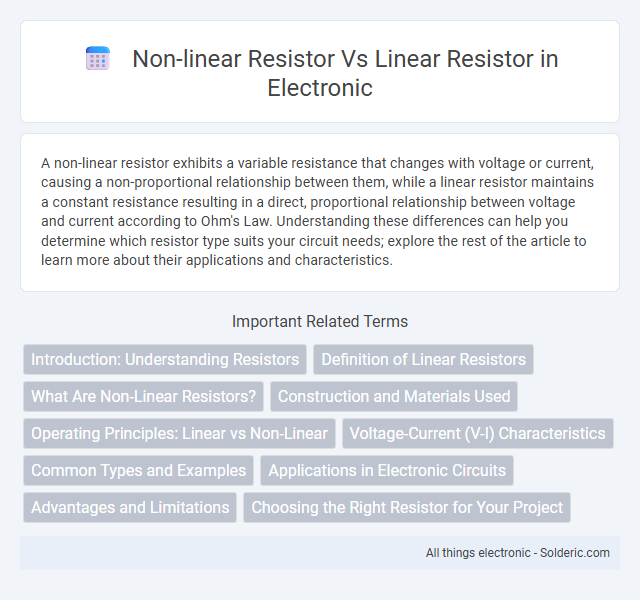A non-linear resistor exhibits a variable resistance that changes with voltage or current, causing a non-proportional relationship between them, while a linear resistor maintains a constant resistance resulting in a direct, proportional relationship between voltage and current according to Ohm's Law. Understanding these differences can help you determine which resistor type suits your circuit needs; explore the rest of the article to learn more about their applications and characteristics.
Comparison Table
| Feature | Non-Linear Resistor | Linear Resistor |
|---|---|---|
| Voltage-Current Relationship | Non-linear (I V/R) | Linear (I = V/R) |
| Resistance | Variable with voltage or current | Constant |
| Examples | Varistors, Thermistors, Diodes (in some regions) | Carbon film, Metal film, Wire wound resistors |
| Application | Surge protection, temperature sensing | Circuit current limiting, voltage dividing |
| Power Dissipation | May vary due to changing resistance | Predictable and stable |
| Symbol | Non-linear symbol varies by type | Standard resistor symbol (zigzag or rectangle) |
Introduction: Understanding Resistors
Non-linear resistors exhibit a resistance value that changes with applied voltage or current, unlike linear resistors that maintain a constant resistance regardless of these factors. Devices like varistors and thermistors demonstrate non-linear behavior, crucial for voltage regulation and temperature sensing applications. Understanding these differences helps you select the appropriate resistor to optimize circuit performance and reliability.
Definition of Linear Resistors
Linear resistors maintain a constant resistance value regardless of the voltage or current passing through them, adhering to Ohm's Law with a direct proportionality between voltage and current. Their resistance remains stable over a wide range of operating conditions, making them predictable components in circuits. Common examples include carbon composition and metal film resistors, widely used in electronic devices for precise control of current flow.
What Are Non-Linear Resistors?
Non-linear resistors exhibit a resistance that changes with the applied voltage or current, contrasting with linear resistors which maintain a constant resistance regardless of electrical conditions. These components, such as varistors and thermistors, are crucial for protecting circuits from voltage spikes and temperature variations. Understanding the characteristics of non-linear resistors can help you optimize circuit performance and enhance device longevity.
Construction and Materials Used
Linear resistors are typically constructed using uniform materials like carbon film, metal oxide, or wire wound elements, designed to maintain a constant resistance regardless of applied voltage or current. Non-linear resistors, such as varistors and thermistors, are made from semiconductor or ceramic materials whose resistance varies with voltage, temperature, or current changes due to their unique construction. The precise material composition and structural design in non-linear resistors enable dynamic electrical characteristics essential for applications like surge protection and temperature sensing.
Operating Principles: Linear vs Non-Linear
Linear resistors operate under Ohm's Law, maintaining a constant resistance where voltage and current have a directly proportional relationship, resulting in a straight-line characteristic on a V-I graph. Non-linear resistors exhibit a variable resistance depending on the applied voltage or current, causing their V-I curve to bend or change shape, which affects circuit behavior under varying conditions. Understanding these operating principles helps you choose the right resistor type for precise control or dynamic response in electronic applications.
Voltage-Current (V-I) Characteristics
Non-linear resistors exhibit Voltage-Current (V-I) characteristics where the relationship is not proportional, resulting in a curve that changes slope depending on the voltage or current applied. Linear resistors maintain a constant resistance, showing a straight-line V-I graph according to Ohm's Law, where voltage and current vary directly. The non-linear behavior is crucial in applications like varistors or diodes, where varying resistance with voltage protects circuits or controls current flow.
Common Types and Examples
Non-linear resistors, such as varistors and thermistors, exhibit resistance that changes with voltage or temperature, commonly used in surge protection and temperature sensing applications. Linear resistors, including carbon film and metal oxide resistors, maintain a constant resistance regardless of voltage or current, making them ideal for precise voltage division and current limiting. Understanding the differences between these resistor types helps you select the right component for your electronic circuit's stability and performance needs.
Applications in Electronic Circuits
Non-linear resistors, such as varistors and thermistors, are essential in electronic circuits for voltage regulation, surge protection, and temperature sensing due to their variable resistance characteristics under different electrical conditions. Linear resistors provide consistent resistance, making them ideal for precise current limiting, voltage division, and biasing in amplifier circuits. Your choice between non-linear and linear resistors depends on the requirement for stability or responsiveness to environmental changes within the electronic system.
Advantages and Limitations
Non-linear resistors offer advantages in protecting circuits by varying resistance with voltage or current changes, enabling surge suppression and voltage regulation unlike linear resistors with fixed resistance. However, their non-linearity complicates circuit design and analysis, limiting precise control and predictability compared to linear resistors that maintain consistent resistance for straightforward applications. Non-linear resistors excel in specialized roles such as transient voltage suppression while linear resistors remain preferable for stable, linear signal processing and simple circuit functions.
Choosing the Right Resistor for Your Project
When selecting the right resistor for your project, understanding the distinction between linear and non-linear resistors is crucial. Linear resistors maintain a constant resistance regardless of voltage or current changes, making them ideal for precise and predictable circuit behavior. Non-linear resistors, such as varistors or thermistors, change resistance based on conditions like voltage or temperature, offering protection or sensing capabilities tailored to specific applications.
non-linear resistor vs linear resistor Infographic

 solderic.com
solderic.com